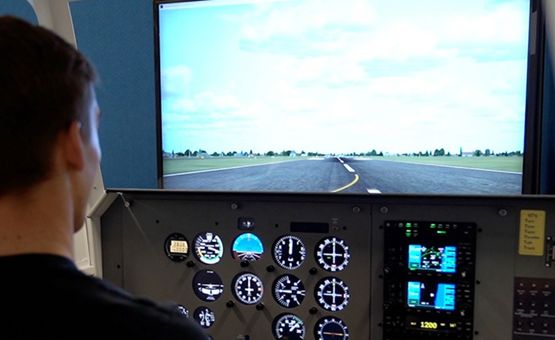By Tim Genc
Here’s a question: How many hours in a training device or simulator can you use in a private pilot license program or airline academy? This seems like a pretty straight-forward and simple question, right? Well, let’s see… According to the FARs and associated Advisory Circulars, and I’m going to paraphrase here, up to 2.5 hours can be used toward the minimum hours in an airline academy.
There’s our answer, right? Wrong.
Let’s look at that answer: up to 2.5 hours toward the minimums. Now, how many of us have received, or are going to receive, our private certificate at the minimum 40 hours of flight time? Probably not a lot of us, and for those of us who do or did, we would probably all agree that additional education would have been helpful and desirable. So, if we can use up to 2.5 hours of simulator time toward a 40-hour minimum, and let’s say that one of the nationally reported averages to realistically get a private certificate is 70, then couldn’t we potentially say that the maximum hours you can use in one of these training devices is actually 32.5? Think about it; if it’s 2.5 hours for a 40-hour minimum program, and you are 30 hours over the minimum, then all of those hours, assuming they are not being used to meet any of the individual task requirements, like night or cross-country, could be in a simulator.
Of course, on the front-end of someone’s program, there’s no way to know exactly how many hours they will need, so you can’t determine the relative sim-hour minimum at the start of a program. So let’s ask another question: why does someone need more than the absolute, bare-bones minimum hours required by the regulations to get a pilot certificate? Well, it’s probably not because they needed more than 3 hours of night to get their 10 nighttime takeoffs and landings in, and it’s unlikely that 3 hours of dual cross-country was inadequate to accomplish a cross-country flight. It is proficiency. Maybe they got their dual cross-country flight in, but they need more practice with cross-country procedures or navigation, and using the E6B in the air, or using their flight plans, etc. Well, what is the better place to practice these things, and by better, I mean the most educationally effective and economical? I would say that it’s in a ground-based training device for a private license program. How much of learning to land an airplane is the physical landing and flare, and how much of it is pattern procedures, common practices, checklist usage, the setup, and the approach? Can’t the latter list be accomplished on a computer-driven device, regardless of its certification, approval, or whether or not it can go into a logbook? The additional use of the simulator in an airline academy is going to reduce hours over the minimum requirement, so use it generously!
You can accomplish a lot more in an hour of simulator/FTD/AATD/PCATD training than you can in an airplane, and while that hour may not replace a required hour in a plane, it certainly can replace a needed but optional hour in a plane. What I mean is that after 2.5 hours in a sim, we can’t count any more hours toward the 40-hour minimum, but we can credit those hours toward the additional proficiency education that is needed to learn to fly.
Why do airlines use simulators? Why did NASA use simulators? Why do driver’s education schools use simulators? It’s the same reason that golfers use driving ranges, and why schools have fire drills: it gives us a safe, controlled, effective and more efficient way to learn, practice and hone procedures. For that reason, a flight training device of some sort is incredibly beneficial to your education as well as for proficiency and refresher work.
We all want to become good pilots, we all want to stay good pilots, and we would all love to save time and money while doing it, right? In American Flyers airline academy, simulation solves all the problems. It gives us the chance to practice IFR and VFR procedures and maneuvers, it gives us the opportunity to go through emergencies more thoroughly, it lets us fly a cross-country flight we’re planning with family and load up the scenario with the unexpected, and it lets us do all of these things independent of actual weather, fuel costs, or maintenance issues. Simulators make our lives easier and also make us better pilots.
So, back to our initial question, how many hours in a training device or simulator can you use in a private pilot license program? The answer: as many as you need. The proficiency and education you gain is invaluable and can help you keep your aircraft hours that much closer to the minimums while keeping your skills sharper and more polished.










